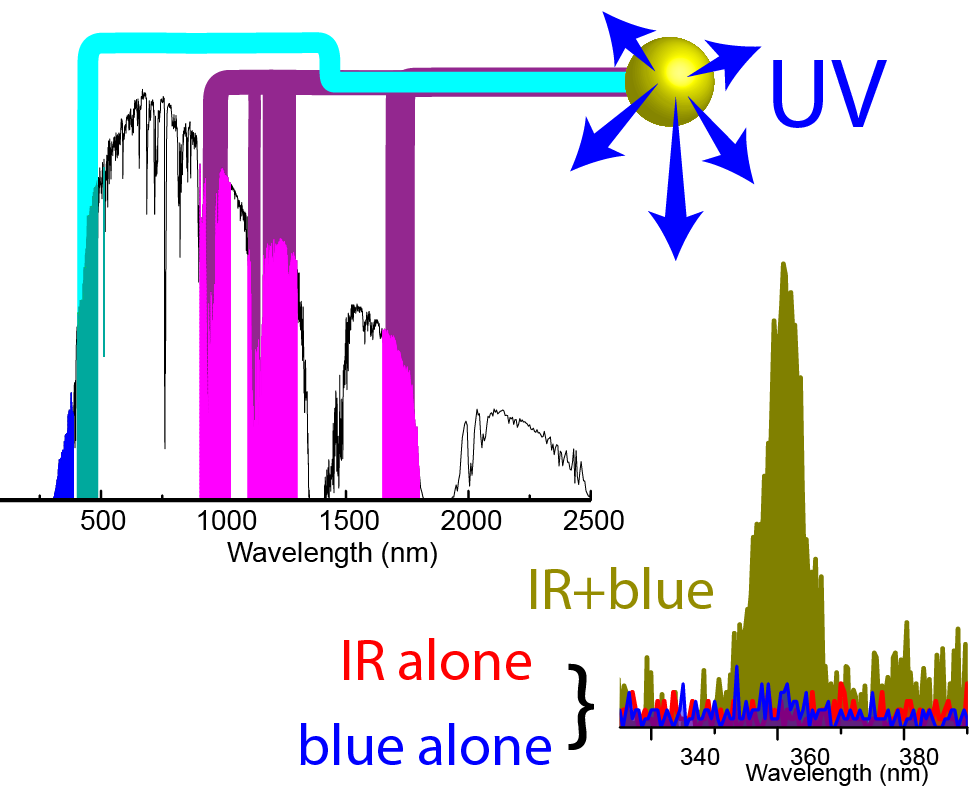
Comment additionner deux photons de couleur différente
How to add two photons of different "colors"
Bhagyesh Purohit, Yannick Guyot, David Amans, Marie-France Joubert, Benoit Mahler, Christophe Dujardin et Gilles Ledoux, (équipe luminescence), en collaboration avec des collègues de Lyon, ont publié un article intitulé "Multi-color solar absorption as a synergetic UV up-conversion enhancement mechanism in LiYF4:Yb3+,Tm3+ nanocrystals" dans la revue ACS Photonics. Cet article fait l'objet d'une actualité scientifique de l'INP, institut de Physique du CNRS, intitulée « Des nanocristaux pour créer des UV à partir du rayonnement solaire »
Bhagyesh Purohit, Yannick Guyot, David Amans, Marie-France Joubert, Benoit Mahler, Christophe Dujardin and Gilles Ledoux (team luminescence), with colleagues from Lyon, published an article entitled "Multi-color solar absorption as a synergetic UV up-conversion enhancement mechanism in LiYF4:Yb3+,Tm3+ nanocrystals" in the journal ACS Photonics. This article is the subject of a scientific news from the INP institute of Physics (CNRS) entitled "Nanocrystals to create UV from solar radiation".
La plupart des photocatalyseurs ne sont efficaces que sous une excitation ultraviolette peu présente dans la lumière solaire et absente dans les lumières intérieures. De ce fait les propriétés de dépollution ou d’auto-nettoyage des peintures ou des bétons sont amoindries.
Les auteurs ont montré qu’en utilisant un matériau à upconversion il était possible d’additionner deux photons d’énergie différente (un proche infrarouge et un bleu) pour générer un photon ultraviolet et ce avec une densité d’excitation comparable à celle du soleil. Ce résultat permet d’envisager le développement de matériaux composites avec de forts gains photocatalytiques.
Les auteurs ont montré qu’en utilisant un matériau à upconversion il était possible d’additionner deux photons d’énergie différente (un proche infrarouge et un bleu) pour générer un photon ultraviolet et ce avec une densité d’excitation comparable à celle du soleil. Ce résultat permet d’envisager le développement de matériaux composites avec de forts gains photocatalytiques.
Most photocatalysts materials are efficient only under ultraviolet excitation. This excitation only represents 1% of the solar photon and almost nothing for indoor lighting. Therefore, depolluting or self-cleaning properties of painting and concrete are partly below expectations.
The authors have developed an upconverting materials which bypass this drawback. The energy summation of two photons of different energies (one infrared and the other blue) efficiently generates one UV photon, even at excitation densities comparable to those of solar irradiation. This results provide new insight for the development of composites materials with enhanced photocatalytic properties.
The authors have developed an upconverting materials which bypass this drawback. The energy summation of two photons of different energies (one infrared and the other blue) efficiently generates one UV photon, even at excitation densities comparable to those of solar irradiation. This results provide new insight for the development of composites materials with enhanced photocatalytic properties.


















